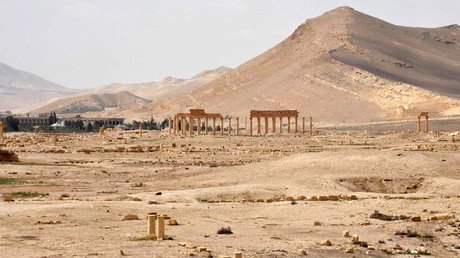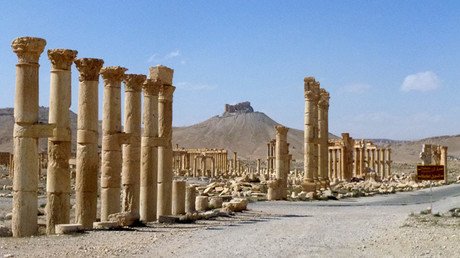‘Palmyra damage monstrous, but mendable’: Experts accept challenging task to restore ancient city
The plans to restore Palmyra to its former glory are grand but feasible, if it is treated as a task of global importance, experts told RT. Russia’s State Hermitage museum has already promised to help remedy the damage suffered by the ancient Syrian city.
The destruction of ancient monuments in Palmyra became an irreparable loss to human civilization, the deputy director of Russia’s State Museum of Oriental Art Tigran Mkrtychev told RT, joining the call for the restoration of its heritage. He said that Palmyra is perceived by the world community as something more than just a monument of archaeology of the Ancient East.
“This place is the bridge between the East and the West, is the westernmost point of the Great Silk Road. That is quite a symbolic place in the history of human civilization,” Mkrtychev emphasized.
Drone buzzes Palmyra after Syrian forces retake city from ISIS https://t.co/EAXsu8Kaptpic.twitter.com/GjLusUePuS
— RT Play (@rt_play) March 28, 2016
Mkrtychev urged the international community to collect funds for the restoration of the monument, because Palmyra is an important artifact for the entire humankind, not only the Syrian people.
“If we approach this issue strategically and make this monument a certain consolidation of the forces of the East and the West in restoration of the monument of a global importance, it [Palmyra] can become a ‘brand’ which will unite Eastern and Western civilizations for years to come,” he stressed.
Addressing the issue of some criticism around the fact that international organizations such as UNESCO, supposedly care more about preserving ‘stones’ than human lives, Mkrtychev said these issues should be addressed alongside one another.
“Every human life is unique and can’t be compared with any historical monument. On the other hand, each historical monument is the concentration of many human lives. Not one, but scores of them! Each monument of world culture, including those under UNESCO’s protection, is a concentrated human memory.”
"A human life is valuable in itself, but these stones are no less important. We know many cases where people gave their lives for the stones they cherish.”
‘It’s not just about stones, it’s about people’
Giovanni Boccardi, chief of UNESCO Emergency Preparedness and Response Unit, also commented on this issue, stating that it’s wrong to underestimate the value of cultural artifacts under any circumstances.
“The life of the nation rests on their cultural identity, on beliefs and values that are shared. Syrians themselves really care about their cultural heritage, it’s not by chance that there is so much interest in retaking Palmyra. It’s not just about stones, it’s about people,” Boccardi told RT.
Boccardi expressed relief at the news of the liberation of Palmyra, but emphasized that there is much work to be done.
“It is a relief. We hope it is a step forward towards the future possible restoration of Palmyra as a cultural landmark for the people of Syria and the international community. Some destructions have now been confirmed – and the picture is rather bleak. But from the drone footage we’ve seen that much is still standing,” Boccardi noted.
“As soon as the security situation allows we’d like to go there and conduct a thorough assessment of the site to see what can be done immediately, and then plan a longer-term rehabilitation. Luckily the stone of Palmyra is there, the quarries are still there, it will be possible to extract the same stone with which the temples were done. And also a good thing is that these monuments have been studied carefully for decades, so now we have a very good record of how exactly they look like. Still, it will be a very challenging thing.”
Boccardi stressed the importance of combined effort in restoring Palmyra for the international community.
Russia questions UK silence on retaking Palmyra from ISIS https://t.co/7nnixfaaXBpic.twitter.com/7UDRBRnoM3
— RT UK (@RTUKnews) March 28, 2016
“Palmyra is inscribed on the world heritage list, it is a site of outstanding universal value and belongs to humanity as a whole, and so it is the responsibility of the international community to come together and help Syrians recover this precious site. This is what UNESCO will be doing.”
‘Overwhelming silence on magnificent victory for the civilization’
Apart from UNESCO, there’s so far been little international reaction following the Syrian army’s success in retaking Palmyra.
NATO has declined to comment on the liberation of the ancient city. Apparently as a response to the lack of British officials’ reaction to the victory in Palmyra, the Russian Embassy in the UK posted a picture on Twitter saying – “keep calm and keep silent.”
Liberation of Palmyra a major victory over ISIS.Wonder why @UKagainstDaesh & @foreignoffice keep silent about it pic.twitter.com/BNRPKPZXeN
— Russian Embassy, UK (@RussianEmbassy) March 28, 2016
Marcus Papadopoulos, Editor of Politics magazine, believes the reason why the international community is in no rush to comment on the liberation of the architectural site lies in their own ineffectiveness in fighting terrorists in Syria.
“There is an overwhelming silence in Britain and America on what was not just a magnificent victory of the Syrian army, and not just for Syria, not just for defeating terrorism, but for the civilization. The reason is America and Britain is not genuinely fighting terrorism,” Papadopoulos told RT.
“This victory is a decisive turning point. Now it allows the Syrian army to capture the desert land that stands between Palmyra and the border of Iraq, and the border of Jordan. And it is a great morale boost for the Syrian army, which is the heart and soul for fighting extremists,” Papadopoulos added.
Challenging task to be carried out slowly & carefully
“The damage done to Palmyra architectural monuments is enormous, but it has not been razed to the ground completely. The main symbol of the city – the famous columns, they are standing, and we now have to inspect the site accurately to determine, what else is left there,” Mikhail Piotrovsky, Director of the Hermitage Museum in Russia’s Saint Petersburg, told journalists on Monday.
So far it is difficult to estimate the full extent of the destruction,but when it is safe to visit Palmyra, evaluating the damage will be the first task of those looking to restore the ancient monument.
“The first stage of the work will be to determine, what stones lie there and where they came from, what structure they’ve been a part of. And this evaluation should be carried out very carefully – we need to sort out what is destroyed completely, which structures received partial damage and which ones survived. Then we can create a map of the site and divide responsibilities.”
Piotrovsky stressed that the question of timing should not be essential in the process of restoration, stating that it “must be done very slowly, because if we do it quickly we will significantly lose in quality”.
“We must decide how to reconstruct Palmyra – whether it will be a tourist site or a monument from which you can learn history, the one that can simultaneously be a beautiful place to visit but also a site that will preserve the memory of the terror that took place here in the course of this past year – like the death of the former curator of the site, Khaled Al Assad, who was executed by Islamic State (IS, formerly ISIS/ISIL) for refusing to reveal the position of some artifacts that these fanatics wanted to sell, the deaths and struggle of all those martyrs who shed their blood for the liberation of Palmyra,” Piotrovsky said.
The Hermitage team is ready to come to Palmyra and help with its restoration along with archaeologists and restoration experts from other countries, like Germany and France. Piotrovsky said that they already discussed the prospects with colleagues and that everyone is waiting for the time when local authorities and the army will allow their delegations to come to Palmyra and begin their work.
All quiet on Western front after Syrian forces recapture Palmyra from ISIS (Op-Edge by Danielle Ryan) https://t.co/Kd3m9AWy4w
— RT (@RT_com) March 28, 2016
Piotrovsky also noted the importance and significance of the work for the people of Saint Petersburg, stressing that this city like no other in the world has experience in restoring monuments destroyed by war.
“No other city in the world except for Leningrad [the Soviet name for Saint Petersburg] has experience in restoring ruins by making them a monument of beauty and culture and at the same time a reminder of vandalism. Tsarskoye Selo, Pavlovsk, Peterhof – they’re all monuments erected from scratch to be genuinely beautiful, to be the symbol of victory and at the same time the story of what happened during the war and how fanaticism and vandalism treated culture.”
On Sunday, the Syrian Army recaptured the historic city of Palmyra from Islamic State (Is, formerly ISIS/ISIL) terrorists, who have occupied it since last May. Russian warplanes have provided heavy support from the air. Following the news, Russia's Ministry of Defense announced it will send anti-mine experts and military robots to help clear explosives in the newly liberated city. Syrian officials say numerous booby traps were laid by retreating IS fighters.
The Russian Air Force made 40 flights in the vicinity of Palmyra in the space of 24 hours, hitting 117 targets and killing over 80 militants, the Russian Center for Reconciliation in Syria said Sunday. However, Lieutenant General Sergei Kuralenko, head of the Russian Center for Reconciliation of the warring parties in Syria, told reporters on Monday that Russian Aviation was not used in areas where ancient monuments of architecture are situated.














